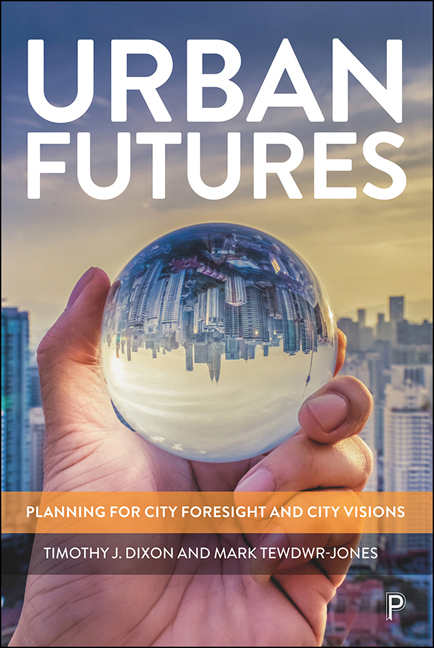Book contents
- Frontmatter
- Contents
- List of figures, tables and boxes
- Acknowledgements
- Foreword
- Preface
- 1 Urban futures: planning for city foresight and city visions
- 2 Cities and integrated urban challenges
- 3 Reimagining the city: views of the future from the past and present
- 4 Planning and governing the future city
- 5 Future narratives for the city: smart and sustainable?
- 6 Theoretical approaches to urban futures
- 7 Using city foresight methods to develop city visions
- 8 Shaping the future: city vision case studies
- 9 The innovative and experimental city
- 10 Visioning and planning the city in an urban age: a reality check
- 11 Conclusions: facing the urban future to 2050 and beyond
- Appendix: selected examples of city visions
- Notes
- References
- Index
6 - Theoretical approaches to urban futures
Published online by Cambridge University Press: 21 December 2021
- Frontmatter
- Contents
- List of figures, tables and boxes
- Acknowledgements
- Foreword
- Preface
- 1 Urban futures: planning for city foresight and city visions
- 2 Cities and integrated urban challenges
- 3 Reimagining the city: views of the future from the past and present
- 4 Planning and governing the future city
- 5 Future narratives for the city: smart and sustainable?
- 6 Theoretical approaches to urban futures
- 7 Using city foresight methods to develop city visions
- 8 Shaping the future: city vision case studies
- 9 The innovative and experimental city
- 10 Visioning and planning the city in an urban age: a reality check
- 11 Conclusions: facing the urban future to 2050 and beyond
- Appendix: selected examples of city visions
- Notes
- References
- Index
Summary
Introduction
The rapid growth of climate emergency declarations in cities across the world in the latter 2010s and early 2020s throws into focus the major structural and institutional changes that will be required in our urban areas to tackle the impacts of climate change. Scientific evidence tells us that, to keep global temperatures from rising by more than 1.5°C, cities have to achieve net-zero emissions by mid-century (Bazaz et al, 2018). This has potentially transformative impacts not only for city economies and people's lifestyles, but also for the multi-level governance structures we see currently at play at national and subnational levels in jurisdictions across the world. As Lord Stern wrote:
We are at a unique moment in human history. The policies and investments made in the next two decades will determine the quality of life on this planet for generations to come. We need cities with net-zero emissions by midcentury to have a reasonable chance of staying close to 1.5°C. Such a transition will need big investments, and quickly, but they are very productive, attractive investments. (CUT, 2019: 4)
The risks of climate change present a clear and present danger to cities. For example, much of the world's population lives in low-lying coastal areas susceptible to flooding by sea-level rise; as a measure of the scale of the risks involved, in Europe 70 per cent of the largest cities have areas that are fewer than 10 metres above sea level, and recent work has shown that people living in poverty, older people and people who are economically vulnerable are likely to be impacted the most by climate change (Kamal-Chaoui and Robert, 2009; Matsumoto et al, 2019). Climate change, therefore, can entrench and deepen systemic and structural inequalities in cities.
Add into the mix the continuing socioeconomic pressures in cities caused by migration, population growth and pandemics, and there is a potent cocktail of urban challenges to be addressed (see Chapter 2). Yet cities also offer great potential for tackling climate change and other environmental issues. For example, it has been calculated that deploying low-carbon measures in cities could reduce greenhouse gas emissions from urban buildings, materials, transport and waste by nearly 90 per cent by 2050. These measures would have a net present value of US$23.9 trillion – greater than the biggest economy in the world, the United States (CUT, 2019).
- Type
- Chapter
- Information
- Urban FuturesPlanning for City Foresight and City Visions, pp. 101 - 122Publisher: Bristol University PressPrint publication year: 2021



